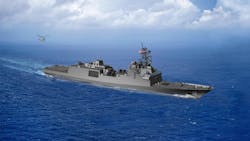Lockheed Martin moves ahead with integrating combat system and sensors for Constellation-class frigate
WASHINGTON – Shipboard sensors experts at Lockheed Martin Corp. are moving ahead with initial design of the combat system aboard the future U.S. Navy Constellation-class frigate (FFG 62) under terms of a $7.9 million order announced Monday.
Officials of the Naval Sea Systems Command in Washington are asking the Lockheed Martin Rotary and Mission Systems segment in Moorestown, N.J., for contract options for combat system ship integration and testing on the future Constellation-class frigate.
USS Constellation will be the lead ship of the Constellation class of guided-missile frigates. Construction of the Constellation is to begin this year following the final design review, and should enter service in 2026. Navy leaders plan to buy 20 ships.
Lockheed Martin is designing the combat management system for the new frigates, based on the company's COMBATSS-21 ship combat management system, which is aboard the Freedom-class littoral combat ships.
COMBATSS-21 is built on an open-architecture scalable framework using non-developmental software, Lockheed Martin officials say. Custom software adapters called boundary components support sensors, communications, and weapon interfaces, and are designed to accommodate future technology insertion and system upgrades with minimal effect on the system[s core software.
Frigates are relatively small, light, and fast surface warships that protect the powerful capital ships, and provide escort protection and help with command and control for lightly armed naval surface warships, as well as to commercial or military merchant ships.
Frigates play a crucial role of keeping naval battle groups together, intact, and functioning in the face of the enemy. They screen ships from aircraft and submarine attack, and can act as advance scouts to determine what's beyond the battle group's horizon.
In addition to developing the combat management system for the Navy's future Constellation-class frigates, Lockheed Martin also builds the Navy's Aegis combat system for Navy Arleigh Burke-class destroyers and Ticonderoga-class cruisers at its Moorestown, N.J. facility.
Lockheed Martin now builds the combat management system for the Navy's Freedom-class littoral combat ships. Independence-class littoral combat ships, meanwhile, use a combat system developed by Northrop Grumman Corp.
The Lockheed Martin COMBATSS-21 architecture isolates shipboard sensors, communications, and weapons from core components of the command and control system to avoid large system bugs and speed software certification.
COMBATSS-21 can run on computer configurations ranging from one commercial processor running a commercial operating system to more distributed configurations, to enable the COMBATSS-21 system adaptable to vessels ranging from patrol craft to large-deck ships, Lockheed Martin officials say.
The Lockheed Martin COMBATSS-21 combat management system borrows technology from Navy Aegis cruisers and destroyers, as well as the U.S. Coast Guard Deepwater program.
Related: A once-proud class of U.S. Navy surface warships is quickly fading away
The overall systems integrator for the future Constellation-class frigates is Fincantieri Marinette Marine in Marinette, Wis. The new ship will displace 6,700 tons of water, will be 496 feet long, 65 feet wide, and draw 26 feet of water. It will be able to steam faster than 26 knots, and will have a range of 6,000 nautical miles. The new frigate will have a 140-member crew.
Shipboard electronics will include the Lockheed Martin COMBATSS-21 combat management system; AN/SPY-6(V)3 Enterprise Air Surveillance Radar (EASR); AN/SPS-73(V)18 surface search radar; AN/SLQ-61 lightweight towed array sonar; AN/SQS-62 variable-depth sonar; AN/SQQ-89F undersea warfare and anti-submarine warfare combat system; and Cooperative Engagement Capability (CEC).
The Constellation-class frigate will accommodate 32 Vertical Launch System cells that can handle RIM-162 ESSM Block 2 and/or RIM-174 Standard ERAM missiles; RIM-66 Standard SM-2 Block 3C; the Naval Strike Missile; RIM-116 Rolling Airframe Missile; Mk 110 57-millimeter gun; and machine guns. The ship will be able to carry one MH-60R Seahawk helicopter and the MQ-8C Firescout unmanned helicopter.
On this order Lockheed Martin will do the work in Moorestown, N.J.; Marinette, Wis.; Bath, Maine; and Pascagoula, Miss., and should be finished by June 2022. For more information contact Lockheed Martin Rotary and Mission Systems online at www.lockheedmartin.com, Fincantieri Marinette Marine at https://fincantierimarinettemarine.com, or Naval Sea Systems Command at www.navsea.navy.mil.

John Keller | Editor-in-Chief
John Keller is the Editor-in-Chief, Military & Aerospace Electronics Magazine--provides extensive coverage and analysis of enabling electronics and optoelectronic technologies in military, space and commercial aviation applications. John has been a member of the Military & Aerospace Electronics staff since 1989 and chief editor since 1995.

